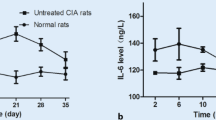Abstract
Very recently, the circadian rhythm was proved to play an important role in the pathogenesis of arthritis. The role of melatonin in the development and progress of rheumatoid arthritis has been implicated for decades. This study was aimed to investigate the effect of melatonin on the expression of circadian clock genes in mouse anti-type II collagen antibody-induced arthritis (CIA). Mice were divided into 3 groups: control, CIA, and CIA + melatonin treatment (MLT). Both mRNA and protein levels of circadian clock gene Cryptochrome1 (Cry1) were markedly decreased in CIA + MEL group compared with those in control and CIA groups. MLT increased paw thickness. Histologic and X-ray assessment also revealed increased infiltration of inflammatory cells, synovial hyperplasia, and the destruction of articular cartilage and bone by MLT. The concentrations of anti-type II collagen antibody in CIA + MEL group mice were significantly higher than those in control and CIA groups (P < 0.05). Serum concentrations of TNF-α (P < 0.005) and IL-6 (P < 0.05) in CIA + MLT group were also increased. Taken together, these results implicate that clock gene Cry1 may be involved in the aggravation of MLT-mediated arthritis in mice anti-type II collagen antibody-induced arthritis.





Similar content being viewed by others
References
Cutolo M, Straub RH, Buttgereit F (2008) Circadian rhythms of nocturnal hormones in rheumatoid arthritis: translation from bench to bedside. Ann Rheum Dis 67:905–908
Forrest CM, Mackay GM, Stoy N, Stone TW, Darlington LG (2007) Inflammatory status and kynurenine metabolism in rheumatoid arthritis treated with melatonin. Br J Clin Pharmacol 64:517–526
Cardinali DP, Garcia AP, Cano P, Esquifino AI (2004) Melatonin role in experimental arthritis. Curr Drug Targets Immune Endocr Metabol Disord 4:1–10
Hashiramoto A, Yamane T, Tsumiyama K, Yoshida K, Komai K, Yamada H, Yamazaki F, Doi M, Okamura H, Shiozawa S (2010) Mammalian clock gene cryptochrome regulates arthritis via proinflammatory cytokine TNF-α. J Immunol 184:1560–1565
Kanbe K, Inoue K, Xiang C, Chen Q (2006) Identification of clock as a mechanosensitive gene by large-scale DNA microarray analysis: downregulation in osteoarthritic cartilage. Mod Rheumatol 16:131–136
Ha E, Choe BK, Jung KH, Yoon SH, Park HJ, Yim SV, Chung JH, Bae HS, Nam M, Baik HH, Hong SJ (2005) Positive relationship between melatonin receptor type 1B polymorphism and rheumatoid factor in rheumatoid arthritis patients in Korean population. J Pineal Res 39:201–205
Maestroni GJ, Sulli A, Pizzorni C, Villaggio B, Cutolo M (2002) Melatonin in Rheumatoid arthritis synovial macrophages show melatonin receptors. Ann NY Acad Sci 966:271–275
Couto-Moraes R, Palermo-Neto J, Markus RP (2009) The immune-pineal axis stress as a modulator of pineal gland function. Ann NY acad Sci 1153:193–202
Cutolo M, Maestroni GJ, Otsa K, Aakre O, Villaggio B, Capellino S, Montagna P, Fazzuoli L, Veldi T, Peets T, Hertens E, Sulli A (2005) Circadian melatonin and cortisol levels in rheumatoid arthritis patients in winter time: a north and south Europe comparison. Ann Rheum Dis 64:212–216
Cernysiov V, Gerasimcik N, Mauricas M, Girkontaite I (2010) Regulation of T-cell-independent and T-cell-dependent antibody production by circadian rhythm and melatonin. International Immunol 22:25–34
Galijasevic S, Abdulhamid I, Abu-Soud HM (2008) Melatonin is a potent inhibitor for myeloperoxidase. Biochem 47:2668–2677
Yilmaz S, Yilmaz E (2006) Effects of melatonin and Vitamin E on oxidative-antioxidative status in rats exposed to irradiation. Toxicol 222:1–7
Fernandes PA, Bothorel B, Clesse D, Monteiro AW, Calgari C, Raison S, Simonneaux V, Markus RP (2009) Local corticosterone infusion enhances nocturnal pineal melatonin production in vivo. J Neuroendocrinol 21:90–97
Lardone PJ, Carrillo-Vico A, Molinero P, Rubio A, Guerrero JM (2009) A novel interplay between membrane and nuclear melatonin receptors in human lymphocytes: significance in IL-2 production. Cell Mol Life Sci 66:516–525
Senel K, Baykal T, Melikoglu MA, Erdal A, Karatay S, Karakoc A, Ugur M (2009) Serum melatonin levels in anlylosing spondilitis: correlation with disease activity. Rheumatol Int. doi:10.1007/s00296-009-1223-x
Brittney JH, Russel RJ, Ahmad N (2010) Sirtuins, melatonin and circadian rhythms: building a bridge between aging and cancer. J Pineal Res 48:9–19
Westhoff G, Buttgereit F, Gromnica-Ihle E, Zink A (2008) Morning stiffness and its influence on early retirement in patients with recent onset rheumatoid arthritis. Rheumatol 47:980–984
Jimenez-Caliani AJ, Jimenez-Jorge S, Molinero P, Guerrero JM, Fernandez-Santos JM, Martin-Lacave I, Osuna C (2005) Dual effect of melatonin as proinflammatory and antioxidant in collagen-induced arthritis in rats. J Pineal Res 38:93–99
Acknowledgments
This work was supported by the research promoting grant from the Keimyung University Dongsan Medical Center in 2009.
Conflict of interest
The authors declare that they have no conflict of interest.
Author information
Authors and Affiliations
Corresponding authors
Rights and permissions
About this article
Cite this article
Bang, J., Chang, H.W., Jung, HR. et al. Melatonin attenuates clock gene Cryptochrome1, which may aggravates mouse anti-type II collagen antibody-induced arthritis. Rheumatol Int 32, 379–385 (2012). https://doi.org/10.1007/s00296-010-1641-9
Received:
Accepted:
Published:
Issue Date:
DOI: https://doi.org/10.1007/s00296-010-1641-9




